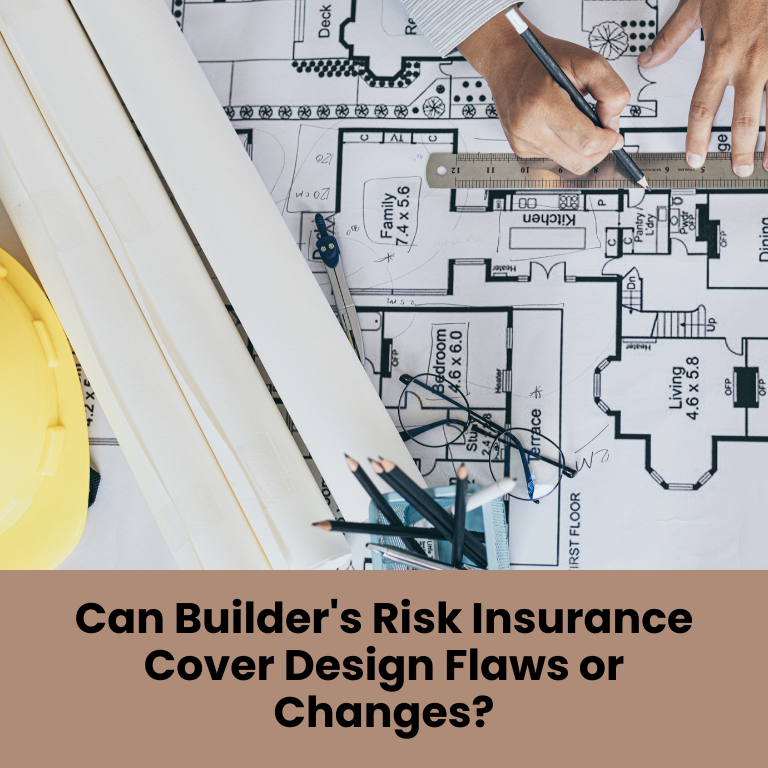Builder’s Risk Insurance: Coverage for Design Flaws and Changes
Builder’s Risk Insurance is a specialized form of property insurance designed to protect construction projects while they are in progress. Contractors, developers, and property owners rely on this coverage to safeguard against unexpected losses that could otherwise derail a project. However, one of the most common areas of confusion is whether this insurance protects against design flaws or project changes.
Generally, Builder’s Risk Insurance does not cover design flaws or project changes. Instead, it covers physical loss or damage to insured property caused by specific perils such as fire, theft, vandalism, or natural disasters. Let’s explore what this means in detail and where coverage may begin or end.
What Builder’s Risk Insurance Typically Covers
Builder’s Risk Insurance policies are tailored to construction projects and typically cover physical loss or damage to a building under construction. Coverage often applies to:
- Fire Damage: Protecting structures from fire during the building phase.
- Theft: Covering stolen building materials or equipment from the job site.
- Vandalism: Addressing damage caused by intentional destruction.
- Weather-Related Events: Such as wind, hail, or lightning, depending on the policy.
- Explosion or Collapse: Coverage for certain sudden and unexpected events that damage the project.
The goal of Builder’s Risk Insurance is to ensure that the investment made into construction materials, labor, and time is protected against accidents or unpredictable events that could cause financial loss.
Why Design Flaws Are Excluded from Coverage
Design flaws represent errors in architectural or engineering plans that can compromise a project’s safety, performance, or quality. Builder’s Risk Insurance excludes these because:
- Preventable by Professional Care: Insurers view design flaws as issues that should be avoided by hiring competent professionals, rather than insurable risks.
- Not a Fortuitous Event: Insurance covers unforeseen losses, not predictable errors like a miscalculated load-bearing structure.
- Professional Liability Coverage Exists: Errors and Omissions (E&O) insurance for architects and engineers is designed to cover claims resulting from design mistakes.
For example, if an architect miscalculates the load capacity of a beam and it fails, causing delays and reconstruction, Builder’s Risk Insurance will not cover the cost of redesigning or rebuilding. Instead, professional liability insurance would respond.
Project Changes and Insurance Exclusions
Construction projects often undergo changes, whether due to client requests, budget shifts, or regulatory requirements. Unfortunately, Builder’s Risk Insurance does not cover losses associated with such changes.
Examples of excluded project changes include:
- Scope Adjustments: Adding an additional floor or altering the layout after construction has started.
- Material Upgrades: Switching to more expensive finishes midway through the project.
- Regulatory Modifications: Altering plans to comply with updated building codes or zoning requirements.
These changes are considered business decisions rather than insurable events. Costs associated with them are expected to be borne by the project owner or contractor.
The Role of Professional Liability Insurance
Because Builder’s Risk Insurance excludes design flaws, construction professionals should consider professional liability insurance, also known as Errors & Omissions (E&O) coverage.
This insurance protects against claims of negligence, mistakes, or oversights in design and planning. For example:
- Architects and Engineers: Coverage for incorrect specifications, miscalculations, or failure to meet standards.
- Contractors: Protection if faulty workmanship arises from following flawed instructions.
Having both Builder’s Risk Insurance and professional liability coverage ensures comprehensive protection throughout a construction project.
Practical Example: A Design Flaw Scenario
Imagine a developer is building a mid-rise apartment complex. The project is insured under Builder’s Risk Insurance for fire, theft, and weather-related losses.
During the framing phase, engineers discover that the foundation design is flawed and cannot support the intended structure. The project requires redesigning and reinforcing the foundation, leading to costly delays and material waste.
- Covered by Builder’s Risk Insurance? No, because the problem stems from a design flaw.
- Covered by Professional Liability Insurance? Yes, if the flaw is attributable to the architect or engineer.
This example illustrates why stakeholders need multiple layers of insurance coverage to manage risks effectively.
What Builders Can Do to Minimize Risk
While Builder’s Risk Insurance has exclusions, contractors and developers can take proactive steps to minimize the risks of design flaws and costly project changes:
- Hire Reputable Professionals: Work with experienced architects, engineers, and consultants who maintain their own E&O coverage.
- Conduct Peer Reviews: Have independent engineers review critical design elements before construction begins.
- Implement Change Management: Establish a process to evaluate the costs and risks of project changes before approval.
- Communicate with Insurers: Review your Builder’s Risk Insurance policy with a broker or advisor to clarify exclusions and available endorsements.
- Consider Policy Endorsements: Some insurers may offer limited coverage for design-related issues through endorsements, though these are not standard.
How Coverage Gaps Can Affect a Project
Failing to understand what Builder’s Risk Insurance excludes can have serious financial consequences. Common issues include:
- Unexpected Costs: Redesigning and rebuilding after discovering flaws can strain budgets.
- Delays: Fixing issues can push timelines back, affecting delivery dates and client relationships.
- Legal Disputes: Contractors, designers, and owners may disagree over who is responsible for additional costs.
- Loss of Confidence: Repeated changes or flaws can erode trust between stakeholders.
Being proactive about insurance planning helps avoid these outcomes.
Consulting Experts for Tailored Coverage
Because Builder’s Risk Insurance policies vary depending on the insurer, project type, and region, it is crucial to consult with an insurance professional. They can:
- Analyze your project’s risk exposure.
- Clarify what perils are covered and what exclusions apply.
- Recommend complementary coverages like professional liability, general liability, or subcontractor insurance.
- Advise on policy endorsements that could close gaps.
With expert guidance, project owners and contractors can ensure they are not caught off guard by exclusions.
Builder’s Risk Is Vital, but Limited
Builder’s Risk Insurance remains a cornerstone of construction project risk management. It provides essential protection against unforeseen physical damage caused by perils like fire, theft, vandalism, or natural disasters.
However, it does not cover design flaws or project changes, as these are considered predictable risks or business decisions. To address those exposures, stakeholders should secure professional liability insurance and establish strong project management practices.
By understanding the scope and limits of Builder’s Risk Insurance and consulting experts to design a comprehensive risk management strategy construction professionals can protect their investments, manage risks, and deliver successful projects with confidence.












